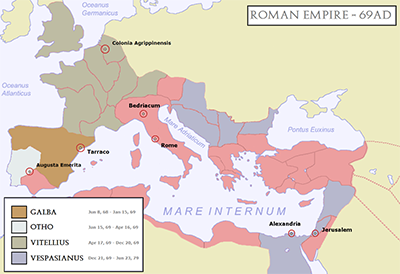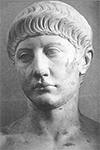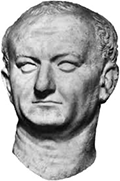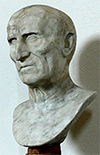Rome: the Year of the Four Emperors
The Year of the Four Emperors was a period of unrest in the early Roman Empire, a 12-month period in which four men claimed the Roman throne. Since the waning years of the reign of the first Roman emperor, Augustus, the man on the throne had made plans for the next man to sit on the throne. The next three emperors (Tiberius, Caligula, and Claudius) were all from the same bloodline, more or less, and so succession was accepted by at least one of the three necessary elements of Roman society: the people, the Senate, and the Army. The fourth emperor, Nero, however, did not so provide. Faced with a revolt by nearly all of the populace in 68, he killed himself, leaving behind no succession plan. The year following was known as the Year of the Four Emperors because it was literally that. 
The first to take the Roman throne after Nero's death was Servius Sulpicius Galba. Governor of Spain, he had declared himself an enemy of Nero and, joining with Lugdunensis Governor Gaius Julius Vindex, led a revolt against the emperor and his apparatus. Galba was strong enough to seize power, on Jan. 1, 69, after which he set about issuing orders that ultimately made him unpopular as well. He ordered his opponents to be killed, he rolled back some of  Otho, for his part in helping Galba take the throne, had expected to be named the next in line. When Galba gave that honor to someone else, Otho made his own way to the top. He didn't stay on the throne all that long, either, because of events that had been initiated earlier. When Vindex had revolted, the Roman legions in the Rhine region had put down that revolt but then, instead of recognizing Nero as the true emperor or Galba as his successor, chose to profess their allegiance to their own commander, Aulus Vitellius. Commander and troops marched on Rome, determined to see Vitellius on the throne. Otho dispatched an army to meet Vitellius's, and the April 14 Battle of Bedriacum created 40,000 dead soldiers and also resulted in a victory by Vitellius. Seeing his troops defeated, Otho killed himself. 
The Senate approved Vitellius as the new emperor, and the general took over an unstable situation and made it worse. He denied proper burials for the soldiers killed in the battle that made him emperor. He allowed his own soldiers to pillage the countryside while also honoring them with feasts and games paid for by the royal treasury. He didn't take the step of eliminating Otho's supporters by summary execution, but he wasn't making many friends or supporters, either; and it wasn't long until he had to face his own revolt. 
Titus Flavius Vespasianus had seen great success fighting in Britain and in Judea. He was in the Middle East when Vitellius took over, and Vespasian's troops gave him the same sort of acclimation that Vitellius's men had. Vespasian and his legions occupied Egypt, thwarting Rome's grain pipeline, then marched on Rome. The second Battle of Bedriacum, on Dec. 20, 69, ended the opposite way for Vitellius. He died after the battle, tracked down by Vespasian's men, and the Senate declared Vespasian emperor the following day. He did Rome two favors by holding on to his throne for a decade and then passing it on to his son.
|
|
Social Studies for Kids
copyright 2002–2025
David White



 the few reforms that had made Nero popular, and he refused to reward the
the few reforms that had made Nero popular, and he refused to reward the 
